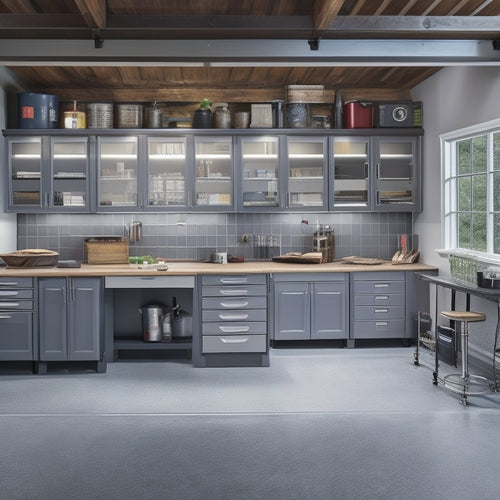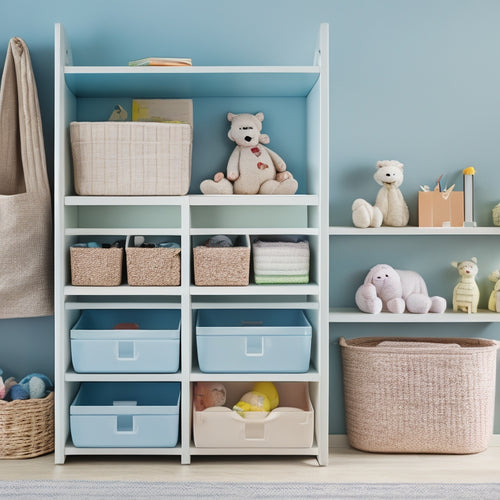
3 Key Steps to Streamline Your Workshop Organization
Share
You're likely wasting 30% of your workshop's productivity and profitability due to disorganization, a common problem that affects 80% of workshop owners. To turn things around, you'll need to assess your current state by evaluating your layout, tools, and processes to identify time and resource wastage. Next, purge and optimize your tools by eliminating duplicates, broken tools, and organizing the remaining ones by category or frequency of use. Finally, implement efficient systems by introducing workflow automation, digital organization, and tracking inventory and tasks effectively. By following these three key steps, you'll be well on your way to releasing a more efficient and profitable workshop operation.
Key Takeaways
- Conduct a thorough workshop appraisal to identify time and resource wastage due to disorganization and create a comprehensive list of resources.
- Purge and optimize tools by eliminating duplicates, removing broken tools, and organizing remaining tools by category or usage frequency.
- Implement efficient systems by introducing workflow automation, digital organization tools, and effective tracking of inventory, schedules, and tasks.
- Create a logical workspace layout to minimize search time for tools and facilitate easy location of materials.
- Track and evaluate resource inventory regularly to ensure condition, safety, and minimize unnecessary purchases.
Assess Your Current State
About 80% of workshop owners struggle with disorganization, which hinders their productivity and profitability. You're likely no exception. To get your workshop organized, you need to start by evaluating your current state. This means taking a close, honest look at how things are currently running.
Begin by conducting a current appraisal of your workshop's layout, tools, and processes. Walk through your workshop, taking note of what's working and what's not. Identify areas where you're wasting time or resources due to disorganization.
Make a list of your resources, including tools, equipment, and supplies. This will give you a clear overview of what you have to work with.
Next, take stock of your resource inventory. What tools do you have? Are they in good condition? Are there any duplicates or redundancies? Are there any tools that are no longer useful or safe?
Purge and Optimize Tools
Now that you have a clear image of your workshop's current state, it's time to tackle the often-daunting task of purging and optimizing your tools. This essential step will help you eliminate unnecessary items, reduce clutter, and create a more efficient workspace layout.
To get started, follow these steps:
-
Conduct a tool inventory: Take stock of every tool in your workshop, including hand tools, power tools, and equipment. Be honest with yourself – when was the last time you used each tool? Is it still in good condition?
-
Identify duplicates and redundant tools: If you have multiple tools that serve the same purpose, consider keeping only your favorite or the one in the best condition.
-
Remove broken or damaged tools: Don't hold onto tools that are no longer functional or safe to use. Dispose of them properly to avoid accidents and free up space.
- Organize remaining tools by category: Once you've purged your tool collection, organize the remaining tools by category or frequency of use. This will help you create a more logical workspace layout and reduce time spent searching for tools.
Implement Efficient Systems
With your tool collection purged and optimized, you're ready to implement efficient systems that will take your workshop organization to the next level.
This is where workflow automation comes in – by streamlining repetitive tasks, you can free up more time for actual work.
Consider investing in a digital organization system, such as a workshop management software, to help you keep track of inventory, schedules, and tasks.
This will allow you to easily locate tools and materials, and make informed decisions about your workshop's operations.
Frequently Asked Questions
How Do I Maintain Organization After the Initial Setup?
You'll maintain organization after the initial setup by consistently using labeling systems and digital tools, like inventory apps, to track supplies and equipment, ensuring you can quickly locate what you need, and keeping your workshop safe and efficient.
Can I Still Achieve Organization on a Tight Budget?
Can you really afford not to get organized? You can achieve organization on a tight budget by utilizing budget-friendly tips and clever organization hacks, such as repurposing items, DIY shelving, and labeling systems that won't break the bank.
What if I Have Limited Workshop Storage Space?
You're working with limited workshop storage space, but don't let that limit you! You're clever, so maximize vertical storage solutions and opt for multi-use furniture to keep your essentials within reach while maintaining a safe and clutter-free workspace.
How Do I Get Others to Follow My New Organizational System?
You're worried that others won't adopt your new system, but don't be - you can get team buy-in by explaining the benefits and involving them in the process. Use clear communication strategies, like regular updates and open feedback, to guarantee a smooth changeover.
Can I Apply These Steps to a Small Workshop or Garage?
You can definitely apply these steps to a small workshop or garage by focusing on small space optimization and strategically planning your workshop layout to maximize efficiency and safety in your compact area.
Conclusion
You've made it! By following these three key steps, you've converted your workshop from a chaotic mess into a well-oiled machine. You've purged your tools of duplicates and dust-gatherers, optimized your workflow, and implemented systems that'll save you a lifetime of frustration. Now, you can find what you need in the blink of an eye, and your productivity will soar to astronomical heights!
Related Posts
-

Best Tool Chests for Home Garage Options
When selecting the best tool chest for your home garage, you'll want to evaluate top brands like DeWalt, Milwaukee, a...
-

Storage Bins for Shelves to Keep Clutter at Bay
You're looking for a way to keep your shelves organized and clutter-free, and storage bins are the perfect solution t...
-

What Size Rolling Storage Bin Do I Need
To determine the ideal size of your rolling storage bin, you'll need to measure your storage space accurately, consid...


